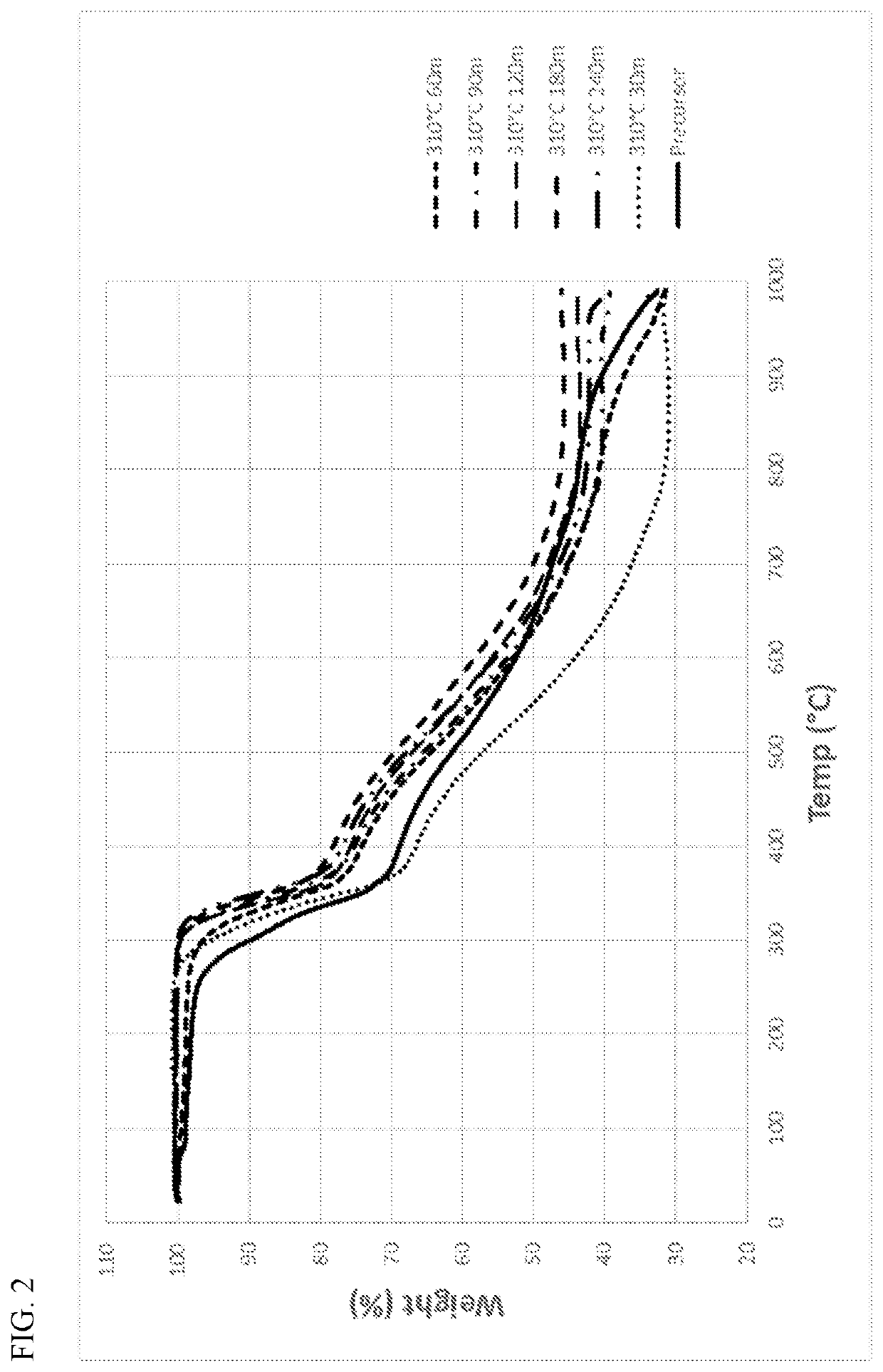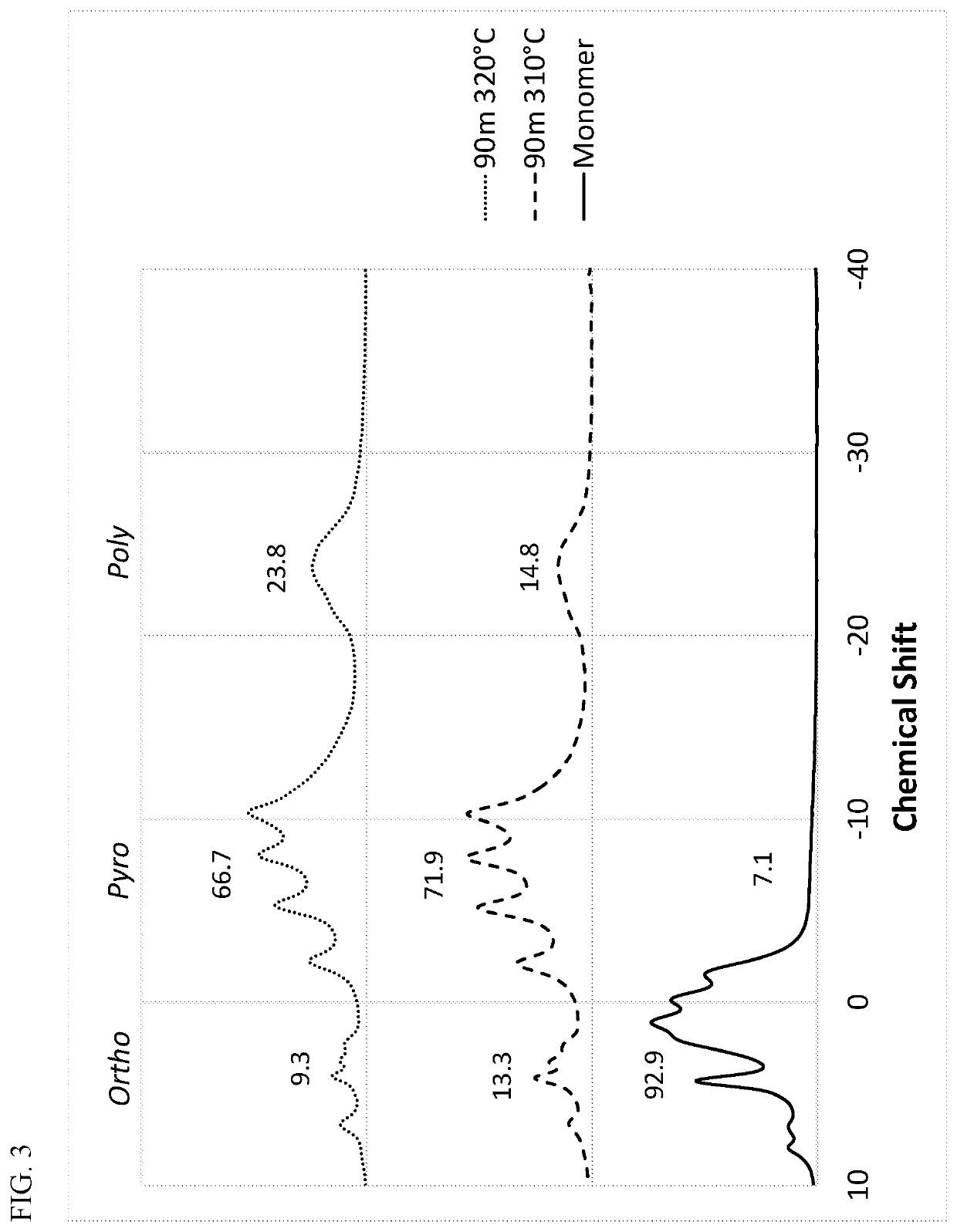Methods for the continuous polymerization of phosphate compounds to form polyphosphate compositions
a technology of polyphosphate composition and polyphosphate compound, which is applied in the field of preparation of polyphosphate composition, can solve the problems of poor operational efficiency and limited production of these polyphosphates
- Summary
- Abstract
- Description
- Claims
- Application Information
AI Technical Summary
Benefits of technology
Problems solved by technology
Method used
Image
Examples
example 1
Polymerization of Melamine Zinc Posphate as a Fnction of Residence Time at a Constant Temperature
[0067]The solid phosphate compound was fed into the upper end of a cylinder of an indirect-fired electric rotary kiln. As the kiln rotated, the compound gradually moved down toward the lower end, and with agitation and mixing provided by a three-pronged lifter inside the cylinder or lifting flights fixed on the inside surface of the rotating tube. The temperature and average residence time of the compound inside the heated zones of the cylinder determines the degree of polymerization of the polyphosphate. The average residence time (t) in the heated cylinder can be determined from Equation (1):
t=1.77*L*θm*ϕ*ω
[0068]where L is the heated length of the cylinder in feet, θ is the angle of repose of monomer powders in degrees, m is the slope of the cylinder along its rotating axis in degrees, Ø is the inner diameter of the cylinder in feet, and ω is the speed of rotation of the cylinder in r...
example 2
Polymerization of Melamine Zinc Phosphate as a Function of Temperature at a Fixed Average Residence Time
[0073]Example 2 was conducted in the same manner as Example 1, except that the temperature was varied and the residence time was fixed. The parameters of the rotary kiln were set to result in a fixed residence time of 90 min. The test temperatures were 310° C. and 320° C. Samples were taken at these temperatures and analyzed with solid state 31P NMR. The NMR spectra are summarized in FIG. 3.
[0074]FIG. 3 demonstrates that the degree of polymerization increases as the temperature increases at a fixed residence time (in this case, 90 min). As the temperature increased, the amount of the phosphate monomer decreased and the amount of polyphosphate increased (values in wt. %).
[0075]For these polyphosphate compositions, Table II summarizes the decomposition onset temperature, the temperature at a weight loss of 2%, and the temperature at a weight loss of 5%, determined using TGA (thermog...
example 3
[0076]Flame Retardant Performance of Polyphosphate Compositions Prepared from Melamine Zinc Phosphate
[0077]Ethylene vinyl acetate (EVA) formulations were produced with (Example 3A) no polyphosphate composition, (Example 3B) 10 wt. % of the polyphosphate composition produced in Example 2 at 320° C. and 90 min, and (Example 3C) 10 wt. % of a polyphosphate composition similar to Example 3B, except produced at 320° C. and 30 min. Table III summarizes the formulations (DuPont Elvax 265 is manufactured by DuPont; Vertex 100 is magnesium hydroxide manufactured by J.M. Huber Corporation; Viton Z 200 is a processing aid manufactured by Chemours; and Irganox 1010 is a sterically hindered phenolic antioxidant manufactured by BASF).
[0078]FIG. 4 illustrates the heat release rate (HRR) curves for the three polymer compositions of Example 3. Cone calorimetry measurements were made according to ASTM E 1354 at 35 kW / m2 on 3 mm thick compression molded plates. Unexpectedly, the formulations of Exampl...
PUM
| Property | Measurement | Unit |
|---|---|---|
| Temperature | aaaaa | aaaaa |
| Temperature | aaaaa | aaaaa |
| Temperature | aaaaa | aaaaa |
Abstract
Description
Claims
Application Information
 Login to View More
Login to View More - R&D
- Intellectual Property
- Life Sciences
- Materials
- Tech Scout
- Unparalleled Data Quality
- Higher Quality Content
- 60% Fewer Hallucinations
Browse by: Latest US Patents, China's latest patents, Technical Efficacy Thesaurus, Application Domain, Technology Topic, Popular Technical Reports.
© 2025 PatSnap. All rights reserved.Legal|Privacy policy|Modern Slavery Act Transparency Statement|Sitemap|About US| Contact US: help@patsnap.com



